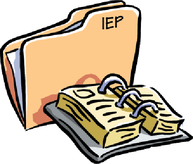In fact, after barely getting half-way through a marathon of back-to-back 30 day interim IEPs for an entire caseload of middle school students, I was starting to think I might never want to hear that acronym again. Then seemingly out of nowhere, while holding a stack of draft IEPs in preparation for the second half of the marathon, something crucially important occurred to me. It may go without saying, but what I realized was that each of those sets of pages represented a child who was somewhat literally and figuratively in my hands. The late nights preparing, the long days of meetings, the commute during rush hour traffic--- all of these efforts were made in my best attempt to support a school community to help each of these kids get what they need and deserve. Unconditional Education is clearly centered around this very concept. Yet, this driving purpose can sometimes get lost amidst the myriad work demands.
|
As this blog post due date approached, I kept thinking to myself, what is something meaningful, timely, and relevant that I want to write about? I will be completely honest and let you all know that the Individualized Education Plan or IEP was the last thing I thought I would choose. In fact, after barely getting half-way through a marathon of back-to-back 30 day interim IEPs for an entire caseload of middle school students, I was starting to think I might never want to hear that acronym again. Then seemingly out of nowhere, while holding a stack of draft IEPs in preparation for the second half of the marathon, something crucially important occurred to me. It may go without saying, but what I realized was that each of those sets of pages represented a child who was somewhat literally and figuratively in my hands. The late nights preparing, the long days of meetings, the commute during rush hour traffic--- all of these efforts were made in my best attempt to support a school community to help each of these kids get what they need and deserve. Unconditional Education is clearly centered around this very concept. Yet, this driving purpose can sometimes get lost amidst the myriad work demands. While there are many ways to reconnect with your purpose, one strategy I suggest is to find ways to re-grounding in a child and family centered approach. When I shift my thinking about IEPs in this way, it helps to humanize the IEP process that can otherwise feel pretty arduous. A place I like to look for inspiration is understood.org. It’s a website full of resources designed to help parents who want the best for their children with learning and attention issues. Referencing articles and resources designed for parents can help shift our focus back to thinking through the lens of the child and family. Here’s one great example! Check out these free Student Profile Templates that can be used to empower students to engage in self-reflection and self-advocacy by preparing a resume of what they want their teachers and school teams to know about them. In addition to the benefits for the child and family, imagine how much more effectively a student prepared resume might be when compared to a case manager distributing a summary form. Resources like this provide a great example of how small shifts in your approach to the IEP process, can make a big difference in the way we see, acknowledge and honor each of our students. If you try it out, please let me know what you think!
1 Comment
6/25/2024 04:27:23 am
Such an inspiring read! 🌟 Re-grounding in a child and family-centered approach truly makes a difference. Love the idea of using student profiles for better IEPs. Thanks for sharing! 📚❤️
Reply
Leave a Reply. |
Authors:School Program Partnerships We're Hiring!Interested in joining our School Program Partnerships' Team? Check out our open positions below!
Categories:
All
Archives
May 2024
|



 RSS Feed
RSS Feed